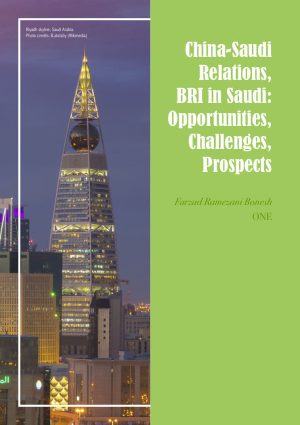 From 1949 to 1990, the two countries were suspicious of each other. China and Saudi Arabia established diplomatic relations in July 1990. But bilateral relations developed in a few decades.
From 1949 to 1990, the two countries were suspicious of each other. China and Saudi Arabia established diplomatic relations in July 1990. But bilateral relations developed in a few decades.
Aligning with China’s positions, Saudi leaders have removed obstacles to the progress of China-Kingdom relations by opposing interference in China’s internal affairs, firmly supporting the “one China” principle and China’s position on Hong Kong, Xinjiang and human rights issues, and facilitating visas.
Over the past decade, Saudi-China relations have developed into a comprehensive strategic partnership that covers various sectors, including energy. The reasons for the growth of strategic relations between Saudi Arabia and China are the emergence of Saudi Arabia as a key power, structural changes in global energy markets, the decline of US hegemony, diversification of diplomatic and economic relations, bilateral visits, the signing of a strategic oil agreement, etc., which are important steps in the development of relations.
In January 2016, China and Saudi Arabia also announced the establishment of a comprehensive strategic partnership. In December 2022, the two countries signed a comprehensive strategic partnership agreement.
Chinese Premier Li Qiang met with Saudi Crown Prince Mohammed bin Salman Al Saud in September 2024, during which the Chinese Premier considered the development of relations with Saudi Arabia as a priority in overall diplomacy in the Middle East diplomacy. Meanwhile, with the strategic approach of the leaders of the two countries, relations and cooperation have expanded in traditional fields such as oil and gas, petrochemicals and emerging fields such as new energy.
Saudi initiatives and BRI
The Belt and Road Initiative (BRI) and Saudi Arabia’s Vision 2030 have many mutual benefits. BRI sees Saudi Arabia as a vital link. The opportunity for China’s BRI to synergize with Saudi Arabia’s priorities emerged in April 2016 with Vision 2030.
The alignment of priorities and plans between China and Saudi Arabia’s Vision 2030 was achieved through high-level meetings between the two countries’ leaders, with agreements covering areas such as energy, establishing subcommittees and designated institutions.
In the eyes of many, such as the Saudi ambassador to China, the BRI and Vision 2030 promote co-development and serve common interests. That is, the two actors complement each other in diversifying, promoting trade, and engaging in mutually beneficial cooperation. Meanwhile, Saudi leaders have actively supported China’s efforts to align with Vision 2030 and avoid tension with China.
Energy cooperation is the foundation of relations, and Beijing is an important importer of Saudi crude oil. Variables such as the attractiveness of the Chinese development model, Beijing’s policy of non-interference in the internal affairs of other countries, the expansion of visits, Beijing’s peaceful development, Saudi Arabia’s joining the BRI, the cooperation mechanism between China and Arab countries, Riyadh’s efforts to maintain stability in the international energy market, non-interference in each other’s internal affairs, etc. have led to the expansion of China-Saudi energy relations.
Energy remains the central area of cooperation between China and Saudi Arabia, 40 percent of China’s total oil imports come from Arab countries, and Saudi Arabia is the largest. China imported about 52 million tons of crude oil from Saudi Arabia from January to August 2024.
The increase in investment in China is evident, especially in petrochemical projects (up to $35 billion). In 2024, China’s oil refineries diversified with Saudi investment.
Saudi Aramco’s contracts with Chinese refineries, the construction of a 10 billion dollar refinery and petrochemical complex, investment in petrochemicals, stock purchases, etc., show the expansion of cooperation in the energy sector. China’s alignment with Vision 2030 has been accompanied by significant investments and contracts, especially in renewable energy. Vision 2030 aims to reduce dependence on hydrocarbons.
In the past years, Saudi Arabia and China to finance, invest and build clean and renewable energy projects solar power plants in Saudi Arabia and BRI member countries. From 2005 to June 2024, Chinese investment in Saudi Arabia amounted to $53.85 billion. Almost a third of China’s investments from 2021 to October 2024 focused on clean technologies.
In the 2030 vision, to diversify away from oil dependence, Saudi Arabia aims to add 20 gigawatts of renewable energy annually and become the world’s largest producer of green hydrogen with $50 billion.
The Chinese are playing a key role in realizing this vision. Several joint ventures between Chinese and Saudi companies have been or are in the process of building large-scale renewable energy generation facilities, energy storage, electric vehicles, carbon capture and clean hydrogen.
The Chinese have acquired a 49 percent stake in Saudi Arabia’s renewable energy holding company ACWA Power. ACWA Power also invests with Chinese companies outside the two countries.
In the past few years, apart from Envision’s participation in the NEOM project and wind turbines, the 2 gigawatts (GW) China-Saudi photovoltaic power plant, the establishment of a special economic zone led by EWPartners to build clean technology generation facilities, an energy storage project with a capacity of up to 7.8 gigawatt hours (the world’s largest energy storage project), and the construction of a $972 million solar power plant by 2024, indicate China’s growing role in Saudi Arabia’s energy transition.
Saudi Arabia is also closely cooperating with China, with Chinese startups and companies involved in the electric vehicle industry.China is helping Riyadh to launch uranium exploration and nuclear industry.
Vision
While China-Saudi cooperation in energy transition has many synergies. With advanced technology and expertise from Chinese companies, Saudi Arabia’s energy resources and energy security will become more diverse. Beijing aims to consolidate its position in the vast Saudi energy market with its massive, long-term investments.
Some predict that by 2030, annual energy-related trade between the Middle East and China will reach $432 billion.
Some critics point to significant and apparent delays in implementing projects in Saudi Arabia, the dependence of many Chinese companies on military institutions, and the lack of transparent costs and corruption.
However, despite China’s increasing oil needs to 13 million barrels of oil imports per day by 2035, the role of energy in the volume of trade is high, and China will remain the top market for Saudi crude.
The multidimensional geopolitical and geoeconomic relations between Riyadh and China, the visionary programs, the complementarity of the economies, technological advances, the continuous investments related to the BRI, etc. can further increase the growth of energy-oriented trade.
It also seems that many in Saudi Arabia still see China as a potential ally, a successful development model, a balancing power in the future. Therefore, Saudi Arabia is likely to be more willing to invest in China.
In addition, the NEOM initiative strategy, the Red Sea project, and the Middle East Green Initiative will be important opportunities for the short-term and long-term prospects of bilateral cooperation between China and Saudi Arabia.
Therefore, energy will remain the cornerstone of the strategic partnership between China and Saudi Arabia.
Farzad Ramezani Bonesh





